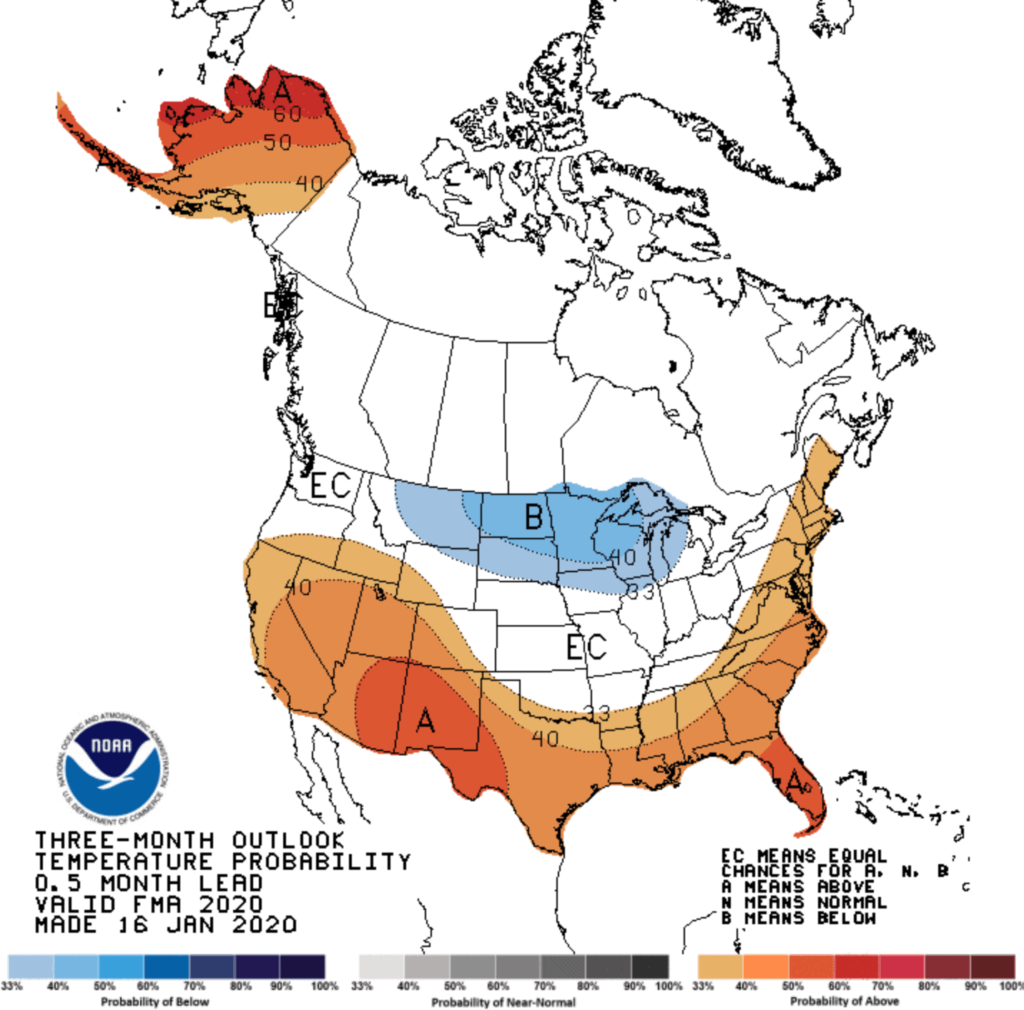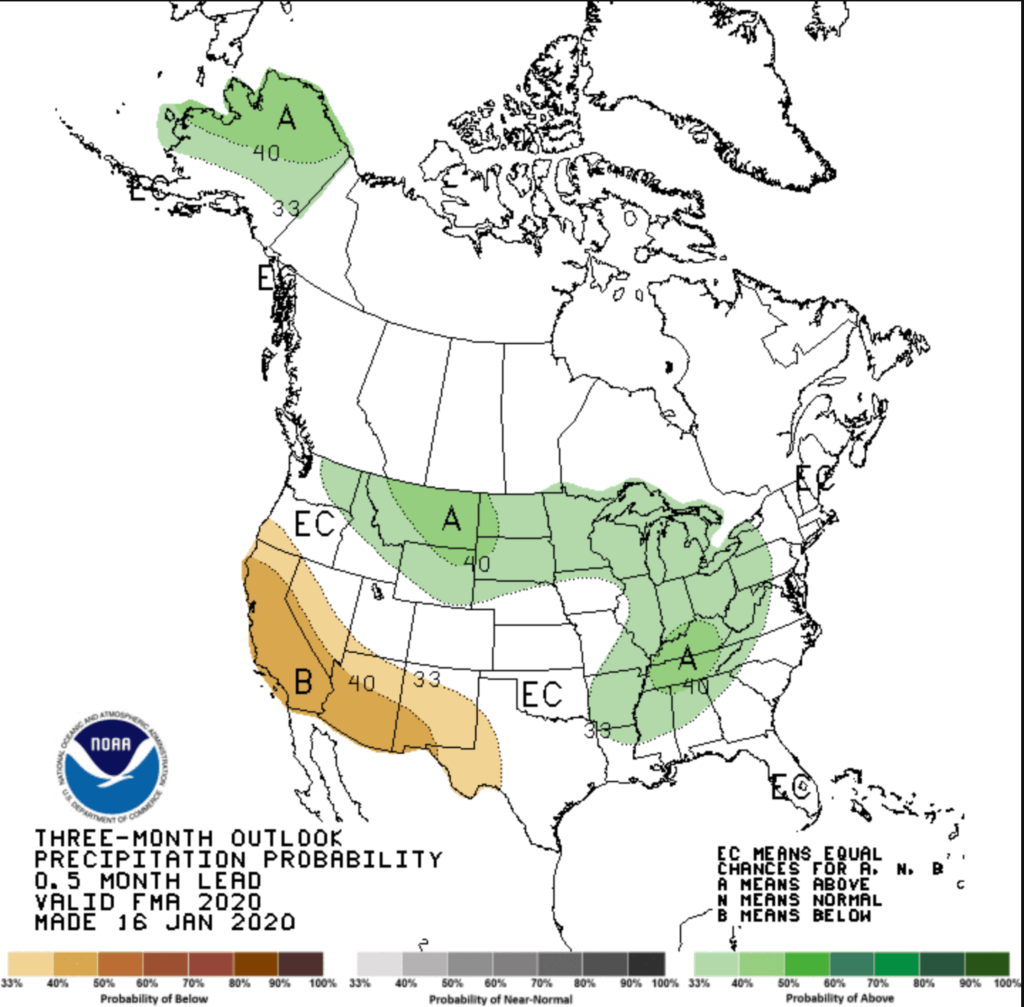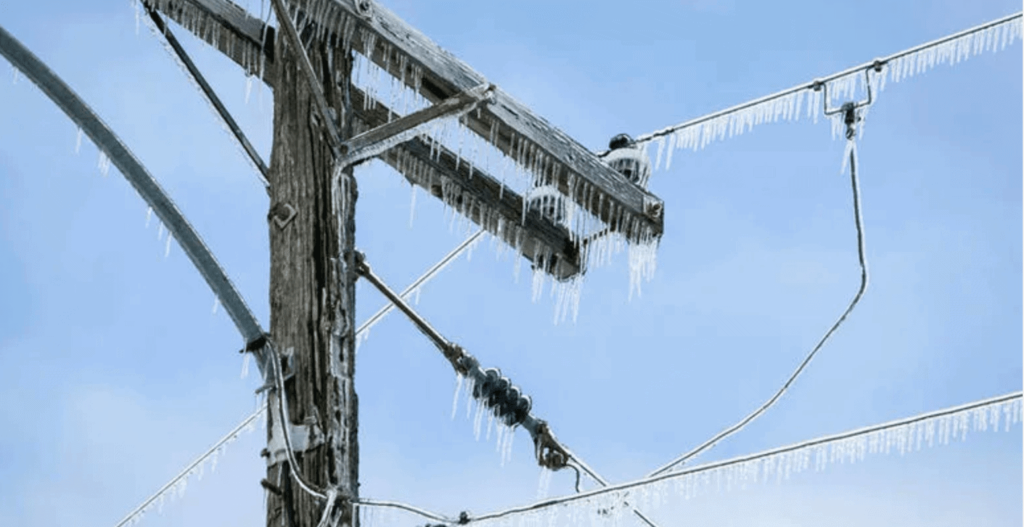
A look ahead at the early months of 2020
By Kevin Juhasz
For Huskie Tools
Groundhog Day is almost here, and it’s time for Punxsutawney Phil to let us know if we’re going to get hit with six more weeks of winter or be blessed with an early spring.
Since most linemen aren’t the type who like to rely on large rodents to handle their weather forecasting, there are better sources available.
One of those is the National Oceanic and Atmospheric Administration, which turns to scientists to let us know how the remainder of the season will bear out. NOAA releases a monthly assessment on how the weather will look, but also offers forecasts further out.
For February, March, and April, NOAA expects that much of the nation will have above-average temperatures, and many areas have an equal chance of above, below or average temps. The only area expected to have below-average temps is in the northern central area of the United States from Montana to Michigan.
Mother Nature, of course, is fickle. As Mike Halpert, Deputy Director of the Climate Prediction Center at NOAA, points out forecasts can shift not just over a few days but within one day.
“Our outlooks are probabilistic. The reality is that anything can happen,” he said. “Over the next couple of weeks, we don’t really see any really cold, Arctic type masses coming in. The outlook for February, a snapshot of the whole thing, again doesn’t favor a whole lot of extremes.”

As far as precipitation, a significant portion of the United States is predicted to have above-average precipitation beginning in February, affecting 20 states in north-central, northeast, and southern states. California, Nevada, Arizona, and New Mexico are expected to have below-average precipitation, and the Northwest, lower Midwest, and East Coast have a chance for precipitation going either way or staying around average.
It’s not just snow and ice that are an issue during the winter. Almost a quarter of tornadoes in the United States occur during the winter months. Tornadoes move faster during the winter months than any other time of the year, making them potentially more destructive.
Flooding is also an issue during the winter months, and several areas are dealing with floods that have lasted since last summer. The other issue that is on the rise is the increase of areas that received snow, but over the last several years, they have seen that precipitation turn to more rain and more flooding.

Regardless of what Mother Nature brings, it’s best for linemen to adequately prepare for the winter. Linework becomes critical in the wake of severe weather.
While most linemen are veterans of riding out the storm, it’s always a good idea to review how to prepare.
The first task is to make sure that your clothing is ready for the possibility of severe cold or storms. Your clothing should keep you warm, but also pull sweat away from your body. This is best done with synthetic fibers, and it’s best to layer so it’s easy to adjust to changing conditions and situations. Since a lot of the work done is with your hands, invest in a good pair of winter gloves that not only keeps you safe, but also keeps you warm. The feet are another area that needs protection, so a pair of boots that are adequate for cold, rain, and snow is needed. Your socks should also be something that helps with warmth. Since there’s a chance you’ll encounter wind or maybe snow, a good pair of safety glasses can help you stay focused on work.
Another area that requires attention is your diet. This is a time when a lineworker will want to stay healthy but start to increase fat intake. This will give your body the fuel it needs to burn and keep you warm. Hydration is also critical while working in the winter. Lots of water. Rest is also critical since it will help you stay focused and mentally prepared for anything that arises.

Winter storms can be a tough time for utility systems. In addition to ice causing extra weight on lines, there’s also the danger that ice and snow can build up on trees, causing branches to snap and cause problems for lines.
Besides making sure that line tools and equipment are ready to handle the winter weather, companies typically keep a closer eye on workers, since the colder weather can cause greater stress.
Much of the preparation for a storm begins before it even hits the region. Companies keep in contact with meteorologists, and some larger companies even have them on staff. In addition to tracking the approaching weather, the company relies on historical data to help them determine the possible outcomes.
The pre-storm work also includes a check of all equipment and inspection of power lines to see if anything needs to be done to minimize the damage.
Companies watch what areas are most affected by the storm as it happens and are able to draw a plan up on what problems need to be tackled and how to go about it. Companies will use their own systems or reports from others to determine the quickest and safest path to make the much-needed repairs. If possible, companies also employ aerial equipment before and after a storm to help assess the situation.

While February is showing signs of above-average precipitation, but little extremes, March and April get a little harder to predict. NOAA does try to help with weather predictions as best they can, but it will likely never be an exact science. This is why the weather outlooks are updated at the end of each month.
“There’s a series of different tools (for weather forecasting). There’s an extensive suite of computer simulations and computer models,” Halpert explained. “The actual map itself is subjectively drawn by a person, looking at all the guidance, and it does reflect some level of confidence in the forecasts.”
When the models show a high probability of a weather occurrence, NOAA will show that in the forecasts. If they can’t be sure, the probabilities are lowered.
The site also offers a look at weather further along the year, going all the way to the end of 2020. However, the further out you go, the less reliable the data. Since it’s updated monthly, those maps are likely to change frequently. As far as the hurricane season in 2020, information on that will not be released until the middle of April.
When it comes to predicting major storms, the science can only look ahead so far. NOAA offers assessments on risks only 14 days ahead, broken down into days 3-7 and days 8-14. This shows the different types of weather, such as precipitation or wind, where the risks are likely, and whether those risks are slight, moderate, or high.
